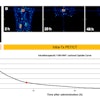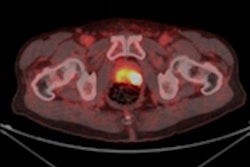
Prostate cancer patients at intermediate or high risk of advanced disease can benefit from either gallium-68 (Ga-68) prostate-specific membrane antigen (PSMA) PET/MRI or multiparametric MRI (mpMRI) alone to diagnose specific features of their disease, according to a study published September 10 in Radiology.
Swiss researchers have found that PET/MRI with a Ga-68 PSMA radiopharmaceutical offers better sensitivity, while multiparametric MRI provides better specificity, especially when determining tumor cell spread beyond the lymph node capsule (extracapsular extension) or when the disease extends into the seminal vesicles (seminal vesicle invasion). However, the difference was statistically significant in only two comparisons.
"Our results suggest that [Ga-68 PSMA-11 PET/MRI] and multiparametric MRI perform similarly in local staging of prostate cancer in patients with intermediate to high-risk prostate cancer," wrote the authors, led by Dr. Urs Muehlematter from University Hospital Zurich. "The increased sensitivity of Ga-68 PSMA-11 PET/MRI for the detection of extracapsular disease comes at the cost of a slightly reduced specificity."
Recent studies have investigated the efficacy of Ga-68 PSMA PET for detecting and localizing prostate cancer, especially with CT and/or MRI. One area that still lacks data, however, is the use of Ga-68 PSMA PET/MRI for local staging of patients with intermediate to high–risk prostate cancer versus multiparametric MRI, the use of which has been shown to reduce unnecessary biopsies. In fact, one recent study showed improved accuracy in predicting extracapsular extension with mpMRI.
The researchers therefore set out to learn which modality is more helpful in determining appropriate therapy and for preoperative surgical planning for patients with suspected extracapsular extension or seminal vesicle invasion.
Muehlematter and colleagues assessed 40 consecutive patients (mean age, 63 years; range, 51-78 years) who underwent Ga-68 PSMA PET/MRI for primary staging of prostate cancer over a two-year period. For comparison, the subjects underwent whole-body multiparametric 1.5- or 3-tesla MRI with a protocol that included T2-weighted fast spin-echo and diffusion-weighted imaging, as well as MRI contrast imaging (Dotarem, Guerbet). The latter was performed within six months of PET/MRI scans, followed by radical prostatectomy within six months of imaging.
For detecting extracapsular extension, Ga-68 PSMA PET/MRI achieved better sensitivity but worse specificity than multiparametric MRI. The results were similar for seminal vesicle invasion, with Ga-68 PSMA PET/MRI providing better sensitivity but worse specificity.
| mpMRI vs. Ga-68 PSMA PET/MRI for extracapsular extension, seminal vesicle invasion | |||
| mpMRI | Ga-68 PSMA PET/MRI | p-value | |
| Extracapsular extension | |||
| Region analysis | |||
| Sensitivity | 28% | 47% | 0.09 |
| Specificity | 94% | 90% | 0.007 |
| Patient-specific analysis | |||
| Sensitivity | 46% | 69% | 0.04 |
| Specificity | 75% | 67% | 0.19 |
| Seminal vesicle invasion | |||
| Region analysis | |||
| Sensitivity | 35% | 50% | 0.09 |
| Specificity | 98% | 94% | 0.007 |
| Patient-specific analysis | |||
| Sensitivity | 35% | 55% | 0.20 |
| Specificity | 75% | 67% | 0.07 |
"Combining the functional information from Ga-68 PSMA-11 PET with the well-established technique of multiparametric MRI might explain the higher sensitivity for the detection of locally advanced disease," the authors wrote.
They also noted that previous studies showed "improved sensitivity for primary prostate cancer detection for Ga-68 PSMA-11 PET/MRI compared with multiparametric MRI, which might allow the reader to focus on locally advanced disease in the regions suspected of harboring primary prostate cancer."
Finally, given the study population, Muehlematter and colleagues cautioned that their results might not apply to patients with low-risk prostate cancer.



















